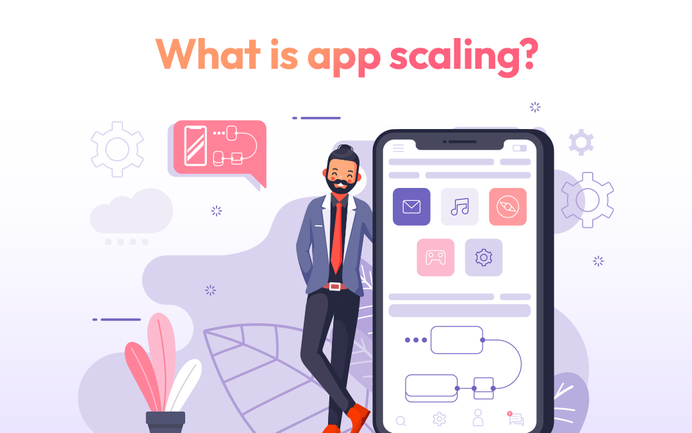What is App Scaling? And Why does it matter in 2023?

Let's consider a scenario where a taxi booking business is being operated through an app, and suddenly, the app becomes quite popular within the region. The user counts are continuously increasing without experiencing any decrease.
The sudden rise cannot be accommodated by your app. The possibility exists that the app's performance might be slowed down or other performance issues might arise.
In this current state of chaos, what actions are to be taken?
The app needs to be scaled, doesn't it? There is no other option available than to proceed with the scaling.
No need to worry, the blog will not be lengthy. We have removed unnecessary details and have arrived at a straightforward examination of app scaling and its significance.
What is app scaling?
The process of enabling your app to handle more users and data is undertaken. This is done to prevent your app from experiencing performance issues. For instance, heavy user traffic can lead to a slower response time, crashes, and errors. This is where the key role of app scaling comes into play.
The role of ensuring that your app performs adequately without compromising its performance is taken on by app scaling.
Allow me to present it differently. What if your app was not scaled?
This could result in a subpar app experience, potentially causing your users to think "I am done here".
The situation of sudden spikes and downtime is addressed by app scaling. Consequently, you can uphold a positive user experience throughout the entirety of their journey.
There exist various methods to achieve this; please remain patient as we approach that point.
Why does app scaling matter?
1. Performance
When an increasingly sudden spike of users or data is observed by your app, it might experience slow responses or become unresponsive. The process of app scaling ensures that your app can navigate through such challenging situations and can emerge from them without delivering a disastrous performance.
2. User experience
Nowadays, it can be observed that super-fast user experiences are being delivered by brands. If your app is slow or fails to meet your user's expectations, alternatives might be sought by them. As a result, your long-term users could end up being lost. The potential to uphold a better user experience is provided by scaling your app.
3. Surpass your competitors
In a competitive world, our tasks are being drastically simplified by AI bots. The key point here is that 'Technologies have advanced', and staying on track is necessary. If you're falling behind, the advantage might be taken by your competitor.
In conclusion, the importance of app scaling lies in the assurance that increased traffic can be accommodated by your app, a hassle-free environment is provided, and a competitive edge is gained.
Types of app scaling techniques?
1. Vertical scaling
The process involves the addition of more hardware resources to a machine, such as CPU, memory, or storage, to the server. This is seen as advantageous, as it incurs a lower cost compared to the acquisition of a new server. However, there are limitations to the extent to which it can be increased. As time passes, the transition to horizontal scaling becomes necessary.
2. Horizontal scaling
It encompasses the process of adding more machines to divide the workload. All this would take a minimum time; however, the process is indeed expensive as we need to integrate the same size server into existing machines.
3. Load balancing
It signifies the distribution of traffic across multiple resources in order to prevent them from becoming overloaded. This guarantees that the app resources are utilized effectively.
It operates between app users and app servers, distributing the traffic based on pre-written rules and algorithms. The rules encompass various factors such as server capacity, availability, and server response time.
4. Caching
Caching entails the storage of frequently accessed data, enabling data retrieval without the need to request from a database. This action can enhance the responsive time of an app. It becomes more effective when the same data is repeatedly read by the client instance.
5. Database Optimization
A reliance upon a database is evident within the application. This becomes apparent as the application expands, leading to the growth of the database.
The improvement of performance and scalability of the system is brought about by database optimization. The goal of achieving database optimization can be realized through several methods.
These methods include:
Index optimization
Quick access to data is facilitated, thus accelerating database queries. Consequently, the time required for data retrieval from the database is reduced.
Query optimization
The enhancement of the efficiency of database queries to manage significant volumes of traffic and data is undertaken.
Performance issues are identified and resolved through query optimization. This is achieved by analyzing query execution, identifying ineffective queries, and optimizing the database schema to enhance query performance.
Compression
The reduction of storage requirements for the database, which in turn improves query performance, is carried out.
End Note
In the present day, businesses are offering users apps, and ensuring a fervent service to them has become essential. From a business perspective, it is imperative to provide a valuable experience to capture the user's interest.
User app experience holds greater significance beyond app design and simple navigation. This experience provides users the choice of whether to continue their affiliation with the brand or not.
Hence, app scaling emerges as a crucial solution.
Are you currently considering the construction of a scalable application? Explore our ready-made marketplace platform; we offer a variety of ready-made applications that evolve alongside business growth.